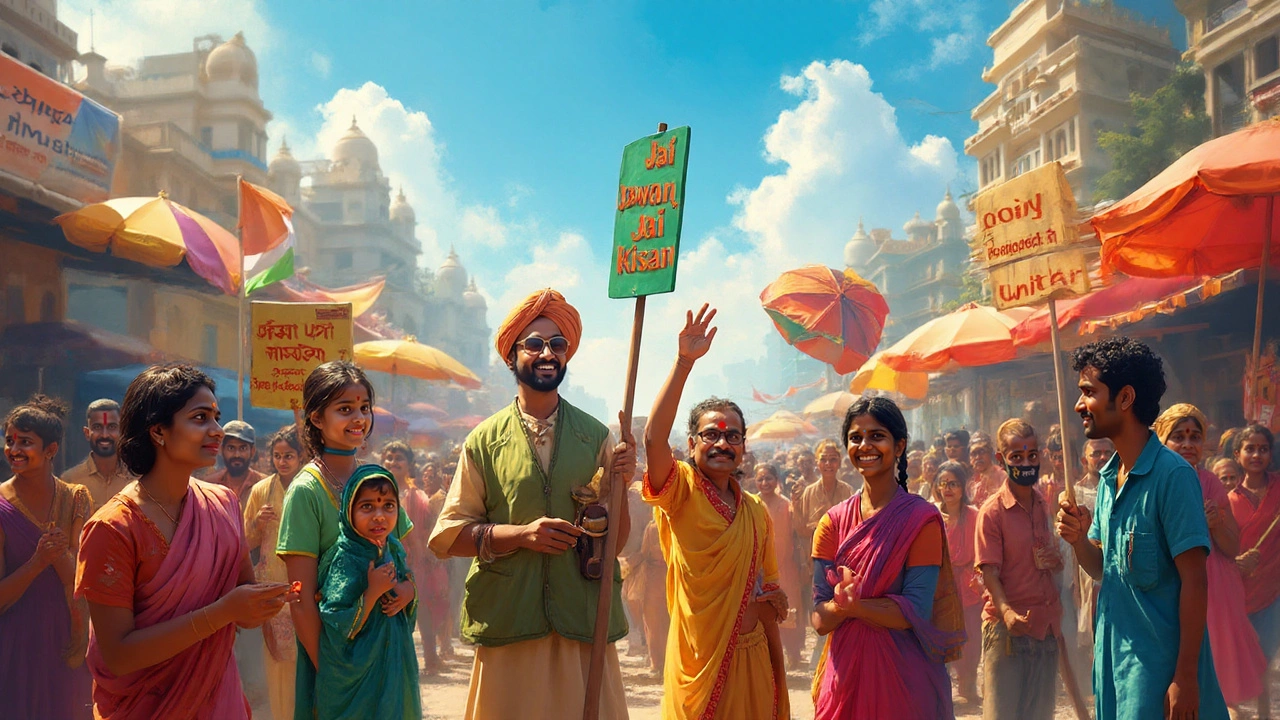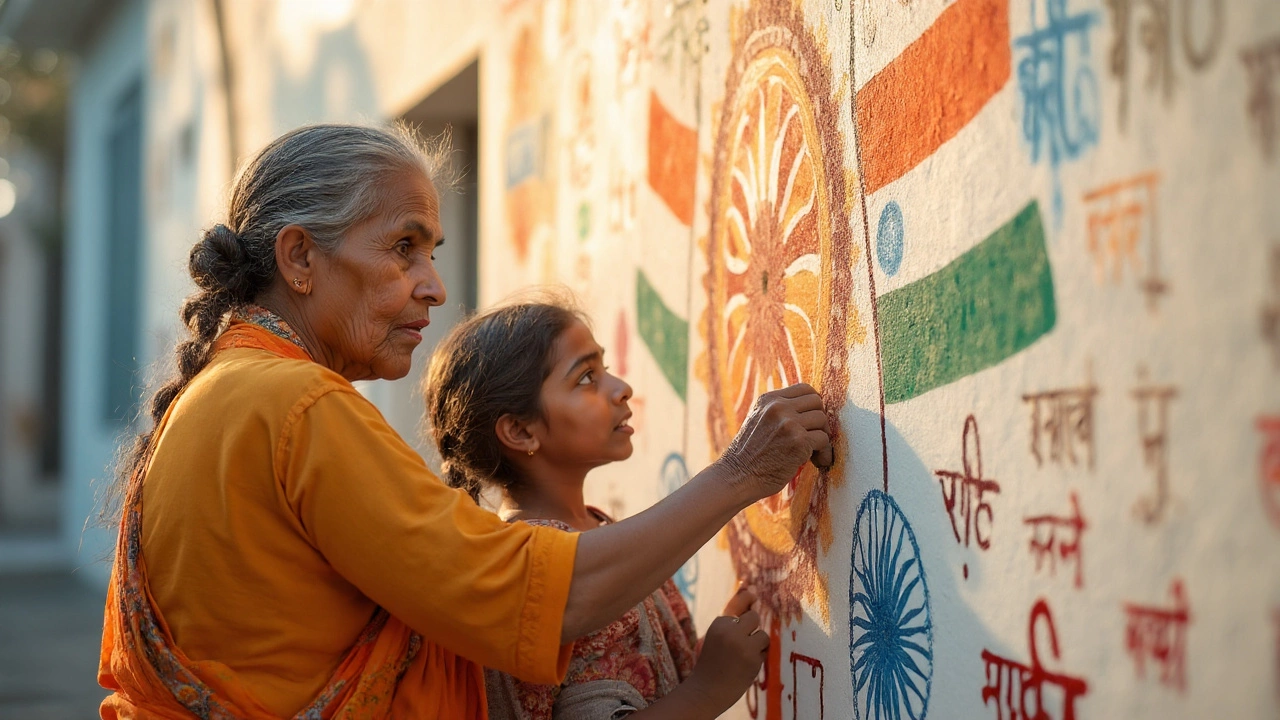
“My India is great!” You’ve probably shouted something like that at least once—on Independence Day at school, maybe, or watching the cricket team play. Slogans about India aren’t just catchy phrases; they’re like little time machines, whisking us back to some of our proudest or most emotional moments as a country. Some are thunderous rallying cries that shaped history. Others turn up quietly in classrooms, offices, on posters, or on social media, reminding us what it means to be Indian today. There’s always a slogan for the occasion, whether for hope, for unity, or for a stubborn burst of national pride.
The Roots: History and Evolution of Indian Slogans
Flip through India’s past and you’ll see slogans pop up at every big chapter. Most folks first think of “Jai Hind” and “Vande Mataram”—short but loaded with meaning. “Jai Hind” (which means simply “Victory to India”) was first popularized by Subhas Chandra Bose, a legend in the independence movement. Did you know it was even used as a formal greeting by the Indian National Army? That phrase became a badge of unity, used by soldiers, politicians, and citizens alike, up to today’s Republic Day parades.
Go back even further, and you find “Vande Mataram” (“I bow to thee, Mother”) from Bankim Chandra Chattopadhyay’s novel, which became the unofficial anthem for the freedom struggle. This slogan would be whispered, then shouted, then sung, as colonizers cracked down. “Swaraj is my birthright, and I shall have it!”—that was Lokmanya Tilak, back in 1916. The British probably got chills hearing it raised by tens of thousands of everyday Indians. It wasn’t just high-flown language; it helped turn regular people into activists.
Then there’s the more rebellious “Inquilab Zindabad!” (“Long live the revolution!”), which Bhagat Singh and his comrades chanted at protests and rallies. Seeing crowds pick it up still sends goosebumps. Another: “Quit India”—the unforgettable 1942 call led by Gandhiji, sparking a wave of united protests, mass arrests, and suspenseful midnight plotting. Every generation found ways to borrow or remix slogans to fit the urgency of its time. Even decades after independence, the echoes remain: “Unity in Diversity”, “Mera Bharat Mahan”, “Satyameva Jayate”—each rooted in key moments and movements.
Slogans in India aren’t always born in government buildings or at big rallies. Some are graffiti on a train, others bubble up from film dialogue, or even cricket fans waving flags in the stands. Think about “Chak De! India”—that started as a sports film punchline, then morphed into a unifying, joyful cheer at every big match. Slogans evolve, crossing from history books into WhatsApp groups, and from freedom struggles right into your living room.
Famous Indian Slogans and Their Stories
India’s gallery of slogans is just packed with drama, emotion, and real stories. Let’s break down a few that are etched into our collective memory. “Jai Jawan, Jai Kisan” (“Hail the Soldier, Hail the Farmer”) was Lal Bahadur Shastri’s answer to a nation in crisis. Famine threatened. Borders needed defending. With those four words, Shastri tied urban and rural, military and agricultural, into a tight hug—reminding India of the backbone of its peace and its bread.
“Garibi Hatao, Desh Bachao” (“Remove Poverty, Save the Nation”) marked a whole era of Indian politics during Indira Gandhi’s rule, promising hope and change. It ignited debate, set off new policies and, for many, became a symbol of dreams and dashed hopes wrapped into one. Another phrase you’ll hear every Republic and Independence Day—“Satyameva Jayate” (“Truth Alone Triumphs”)—is straight from the ancient Mundaka Upanishad. Chosen as our national motto, it’s inscribed below the Lion Capital. Talk about an ancient phrase standing tall in modern governance!
Don’t forget the playful ones, like “Mera Bharat Mahan” (“My India is Great”). This one started featuring on stickers, school walls, and news sign-offs, especially in the early satellite TV boom of the ‘90s. In fact, the line’s popularity grew so much it even found its way to T-shirts, mugs, and WhatsApp DPs. Then there are those slogans that make their way into protest signs whenever students, farmers, or activists flood the streets. “Save the Nation” or “India Against Corruption” echo recent moments when people just wouldn’t sit quietly.
Some slogans get borrowed from the world of sports—“Bleed Blue” or “Chak De! India” finds its roots in cricket and hockey fever, and now shows up as hashtags or status updates wherever there’s a major tournament. Students and teachers swear by “Padhega India, Badhega India” (“India will study, India will grow”), especially during board exams or school admissions season. A catchphrase really can become a rally point, a source of motivation, or the quickest summary of a movement’s goal. One neat fact: As of 2025, the Election Commission actually uses powerful slogans in its voter awareness campaigns (“No Voter to be Left Behind”), which helps turnout rates spike during busy election seasons.
Sometimes, these slogans come with gestures. Think of ordinary people saluting the flag and shouting “Jai Hind,” or schoolkids holding paper doves and chanting “Peace Not War.” The fact that these slogans keep resurfacing—at marches, on political posters, in popular films—shows just how baked-in they’ve become in our sense of being Indian.

How Slogans Reflect Indian Diversity and Spirit
You’d think with hundreds of languages, India’s slogans would get tangled. But they do the opposite: they pull the country together. Take “Unity in Diversity.” This isn’t just a phrase—it’s a fact you’ll experience in any small-town bazaar or on a city street packed with every possible festival, outfit, and dialect. Slogans in India juggle Hindi, English, regional languages—you’ll spot “Jai Maharashtra” in Mumbai, “Jai Telangana” in Hyderabad, or “Apna Punjab, Apni Shaan” at Baisakhi parades.
What’s amazing is how even the simplest slogans find ways to include everyone. At school functions, chants are repeated in multiple languages. Political parties remix classics like “Jai Hind” or “Bharat Mata Ki Jai” in their scripts, making sure the tone matches the crowd. During every major Indian festival—be it Diwali, Eid, Pongal, or Onam—you’ll hear creative mashups: “Diwali Hai, Bharat Ki Shaan Hai” or “India United, Onam Celebrated.” These phrases, sometimes spontaneous and sometimes crafted in boardrooms, act as bridges during fracture or celebration.
The soul of Indian slogans lies in their flexibility. In Kerala, during local protests, the phrase “Jai Kerala” gets mixed with Malayalam rhymes. In Assam, “Jai Aai Axom” rallies the crowd in Assamese. During recent international events—from G20 summits to Olympic broadcasts—anchors have chanted “Nayi Soch, Naya Bharat” (“New Thinking, New India”) reflecting aspirations of a new, digital, connected nation. Slogans work in pop culture too: Bollywood movies drop powerful lines that stick, like “Mere Paas Maa Hai” from Deewar, which found its way into memes and patriotic ad campaigns.
Here’s a quirky fact: Indian railways coaches often display the phrase “Apna Desh, Apni Rail” (“Our Country, Our Railways”) as a morale booster for millions of daily travelers. Even huge government projects get their own slogans—think “Make in India” or “Digital India”—giving a billion people a short, simple phrase to picture a bigger national dream. It’s not just in public life; people use these in everyday chats. Message threads light up with “Desh Ki Baat” or “Proud to be Indian” on August 15 or January 26, and little kids chalk “Bharat Mata Ki Jai” on school blackboards without ever questioning why. It just feels natural—like breathing a little patriotism into the air around them.
Collecting, Using, and Creating Indian Slogans Today
So what’s next for slogans about India? They’re no longer locked away in textbooks. In fact, if you look at Instagram or TikTok reels today, you’ll see new gen Indians rewriting, doodling, and remixing slogans to fit memes, trends, or social movements. Swiping through Independence Day reels, you’ll spot “Har Ghar Tiranga” hashtags on flag-waving selfies. Campaigns for “Swachh Bharat” (“Clean India”) see kids as young as six drawing the slogan in chalk outside their apartment blocks. Even pizza chains and tech startups roll out their own Desi slogans when cricket fever spikes or a new Mars orbiter launches.
If you’re hunting for slogans for a school project, poster, or speech, there’s no shortage. Start with classics:
- “Jai Hind”
- “Vande Mataram”
- “Satyameva Jayate”
- “Mera Bharat Mahan”
- “Jai Jawan, Jai Kisan”
- “United We Stand, Indians We Are”
- “Clean India, Green India”
- “India First, Always First”
- “Proud to Be Indian”
- “We Are One, We Are India”
The best slogans about India never go stale—they just reinvent themselves for each new context, whether on a poster, a tweet, or shouted on the steps of Parliament. From fierce independence fighters to modern students, everyone’s got their favorite. That’s what makes Indian slogans so special: they’re flexible, infectious, and weirdly timeless, acting as glue for a giant, wonderfully chaotic nation. So next time you hear a slogan echoing across a playground or flashing on your phone screen, remember: you’re catching a slice of history, pride, and that wild Indian spirit—all rolled into a few punchy words.